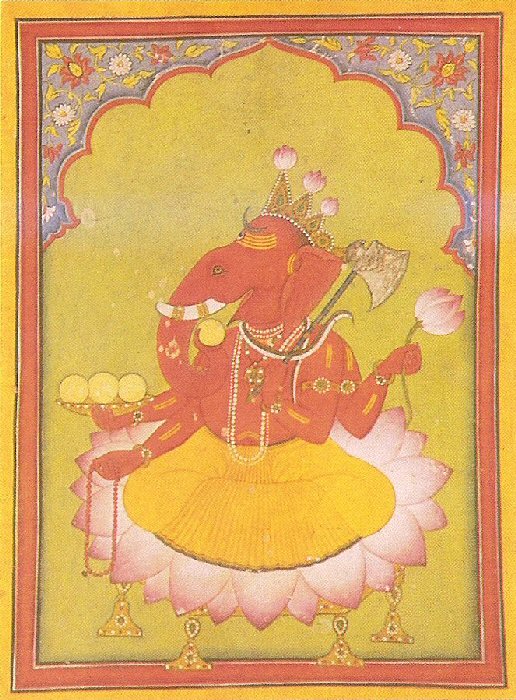|
Ganesh s'apprêtant à lancer son lotus. Miniature de l'Ecole de Basohli, environ 1730. National Museum, New Delhi, Inde.
Source: Cette miniature est reproduite et décrite dans Martin-Dubost, Paul (1997). Ganesha: l'Enchanteur des Trois Mondes, Mumbai: Project for Indian Cultural Studies. ISBN 81-900184-3-4. , p. 73.
"Vêtu d'un dhoti orange, son corps est entièrement rouge. Sur les trois pointes de sa petite couronne, des lotus en bourgeons ont été fixés. Ganesha
tient dans ses deux mains droites le chapelet et une coupe garnie de trois modakas (un quatrième substitué par la trompe recourbée, est tout près d'être
dégusté). Dans ses deux mains gauches, Ganesha tient en haut un grand lotus et en bas une hache dont le manche est appuyé sur son épaule. Dans le Mugalapurâna
(VII, 70), pour venir à bout du démon de l'ego, (Mamâsura) qui l'avait attaqué, Ganesh Vighnarâja lui lança son lotus. Incapable de supporter la fragrance de la fleur divine,
le démon se soumit à Ganesha".
Site Web
|
Ganesha getting ready to throw his lotus. Basohli miniature, circa 1730. National Museum, New Delhi, India.
Source: This work is reproduced and described in Martin-Dubost, Paul (1997). Ganesha: The Enchanter of the Three Worlds. Mumbai: Project for Indian Cultural Studies. ISBN 81-900184-3-4, p. 73,
"Attired in an orange dhoti, his body is entirely red. On the three points of his tiny crown, budding lotuses have been fixed. Ganesha holds in his two right hands the rosary and a cup filled
with three modakas (a fourth substituted by the curving trunk is just about to be tasted). In his two left hands, Ganesha holds a large lotus above and an axe below, with its handle leaning against his shoulder.
In the Mudgalapurana (VII, 70), in order to kill the demon of egotism (Mamâsura) who had attacked him, Ganesha Vighnarâja throws his lotus at him. Unable to bear the fragrance of the divine flower,
the demon surrenders to Ganesha."
Web site
|

